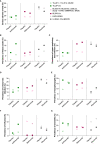Biological drugs for systemic lupus erythematosus or active lupus nephritis and rates of infectious complications. Evidence from large clinical trials
- PMID: 36211360
- PMCID: PMC9538665
- DOI: 10.3389/fimmu.2022.999704
Biological drugs for systemic lupus erythematosus or active lupus nephritis and rates of infectious complications. Evidence from large clinical trials
Abstract
Systemic lupus erythematosus (SLE) is a multisystemic autoimmune disease that frequently affects the kidneys, known as lupus nephritis (LN). Such patients are treated with antimalarials, corticosteroids or immunosuppressive drugs, and more recently, target-specific biological drugs. Although efficacy of these therapies improved SLE-related outcomes, SLE remains associated with higher rates of infections. Here, we performed a comprehensive systemic review of infectious complications in clinical trials covering drug interventions for SLE or specifically for active LN. Our search in 15 online registries yielded a total of 1477 studies of which 14 matched our prespecified criteria. These covered the biological drugs anifrolumab, belimumab, and rituximab that were tested in patients with non-renal SLE and active LN.The available safety data from the SLE trials indicated that infectious complications such as herpes zoster, upper respiratory tract infection, nasopharyngitis, bronchitis, and urinary tract infection in patients receiving placebo were quite prevalent especially in the EXPLORER (rituximab) trial. Infections occurred mostly during the first year of LN therapy. Serious adverse events and infectious complications occurred more frequently in placebo-treated patients with active LN, especially in the BLISS-LN (belimumab) and LUNAR (rituximab) trials. Anifrolumab and rituximab increased the number of clinically relevant episodes of herpes zoster compared to belimumab in patients with active LN. Anifrolumab displayed a similar trend for influenza infections, which is consistent with the specific mechanisms-of-action of anifrolumab; highlighting drug-specific effects on infectious complications. In addition, standard-of-care therapy, e.g., MMF and immunosuppressants, as well as a longer SLE duration may also affect the incidence of serious adverse events and certain infectious complications in SLE patients with active LN.Infectious complications are common in SLE but even more common in patients with active LN, especially herpes zoster is strongly associated with active LN and anifrolumab therapy (OR 2.8, 95% CI 1.18 to 6.66, p = 0.018). Immunotherapy seems to impose unspecific and specific risks for infections. The latter may imply specific precautions such as preemptive vaccination and individual risk-benefit assessments.
Keywords: anifrolumab; belimumab; chronic kidney disease (CKD); herpes zoster; infection; lupus; rituximab.
Copyright © 2022 Steiger, Ehreiser, Anders and Anders.
Conflict of interest statement
H-JA received consultancy or lecture fees from Boehringer, Bayer, GSK, AstraZeneca, Novartis, Otsuka, Janssen, Kezar, Lilly, Sanofi, and PreviPharma. SS has received research funding from Eleva Ltd. The remaining authors declare that the research was conducted in the absence of any commercial or financial relationships that could be construed as a potential conflict of interest.
Figures





Similar articles
-
Interferon Inhibition for Lupus with Anifrolumab: Critical Appraisal of the Evidence Leading to FDA Approval.ACR Open Rheumatol. 2022 Jun;4(6):486-491. doi: 10.1002/acr2.11414. Epub 2022 Feb 14. ACR Open Rheumatol. 2022. PMID: 35157371 Free PMC article.
-
Phase III, multicentre, randomised, double-blind, placebo-controlled, 104-week study of subcutaneous belimumab administered in combination with rituximab in adults with systemic lupus erythematosus (SLE): BLISS-BELIEVE study protocol.BMJ Open. 2019 Mar 20;9(3):e025687. doi: 10.1136/bmjopen-2018-025687. BMJ Open. 2019. PMID: 30898822 Free PMC article.
-
Efficacy of belimumab combined with rituximab in severe systemic lupus erythematosus: study protocol for the phase 3, multicenter, randomized, open-label Synbiose 2 trial.Trials. 2022 Nov 12;23(1):939. doi: 10.1186/s13063-022-06874-w. Trials. 2022. PMID: 36371234 Free PMC article.
-
Lupus Nephritis: New and Emerging Biologic and Targeted Therapies.BioDrugs. 2023 Jul;37(4):463-475. doi: 10.1007/s40259-023-00597-3. Epub 2023 Apr 24. BioDrugs. 2023. PMID: 37093522 Review.
-
Belimumab or anifrolumab for systemic lupus erythematosus? A risk-benefit assessment.Front Immunol. 2022 Aug 31;13:980079. doi: 10.3389/fimmu.2022.980079. eCollection 2022. Front Immunol. 2022. PMID: 36119023 Free PMC article. Review.
Cited by
-
Lessons from SENCOVAC: a prospective study evaluating the response to SARS-CoV-2 vaccination in the CKD spectrum.Nefrologia. 2022 Dec 16. doi: 10.1016/j.nefro.2022.12.006. Online ahead of print. Nefrologia. 2022. PMID: 36540904 Free PMC article. Review.
-
A Framework to Overcome Challenges in the Management of Infections in Patients with Systemic Lupus Erythematosus.Open Access Rheumatol. 2023 Jul 27;15:125-137. doi: 10.2147/OARRR.S295036. eCollection 2023. Open Access Rheumatol. 2023. PMID: 37534019 Free PMC article. Review.
-
Effectiveness and safety of the recombinant zoster vaccine in adult patients with systemic lupus erythematosus: a claims-based retrospective cohort study in the USA.RMD Open. 2025 Aug 7;11(3):e005839. doi: 10.1136/rmdopen-2025-005839. RMD Open. 2025. PMID: 40780731 Free PMC article.
-
Evaluation of the Efficacy and Safety of Anifrolumab in Moderate-to-Severe Systemic Lupus Erythematosus.Cureus. 2024 Jul 6;16(7):e63966. doi: 10.7759/cureus.63966. eCollection 2024 Jul. Cureus. 2024. PMID: 39104974 Free PMC article. Review.
-
Drug-induced herpes zoster: a pharmacovigilance analysis of FDA adverse event reports from 2004 to 2024.Front Pharmacol. 2025 Mar 26;16:1565480. doi: 10.3389/fphar.2025.1565480. eCollection 2025. Front Pharmacol. 2025. PMID: 40206093 Free PMC article.
References
Publication types
MeSH terms
Substances
LinkOut - more resources
Full Text Sources
Medical

